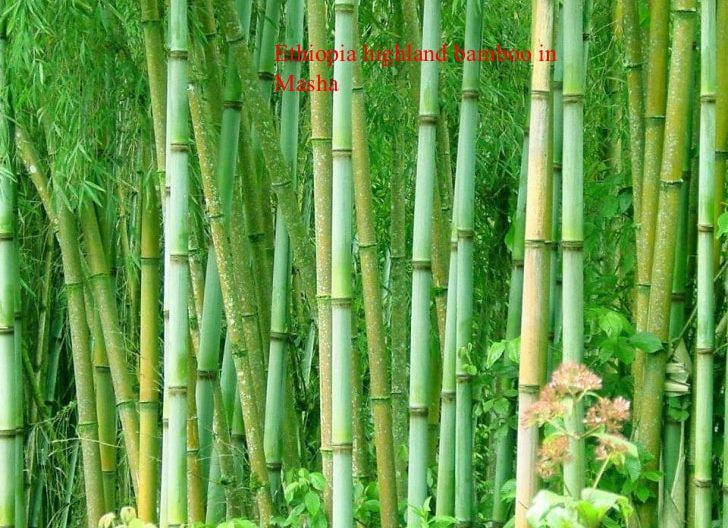
Ethiopia has enormous bamboo forests representing a significant proportion of that of Africa. Studies reflect problems and constraints facing its production and marketing system. They have identified current economic opportunities and challenges of production, marketing, environmental and aesthetic value of bamboo in Ethiopia. These studies cover a wide range of actors from production to marketing systems. The bamboo products in Ethiopia pass through various intermediary stages until they reach the final customers. The bamboo agribusiness has global market opportunities if given proper attention by policy makers.
Bamboo products currently have very huge domestic and external demand. They can be utilized at all levels of industrial activity from small scale handicraft to modern highly integrated plants. The “imbalance” between demand and supply is one of the core challenges to bamboo agribusiness sector in Ethiopia. Demand for bamboo is on the rise for its environmental, aesthetic/cultural values. Bamboo is used in a variety of engineering fields including landscape, civil and chemical engineering. As pointed out by T. Kassahun, bamboo has cultural values in addition to economic and ecological uses in Ethiopia. The longest wind musical instrument in the world called Dinks, for example, is made from bamboo and other materials.
Bamboo has global uses ranging from medicine to nutrition. It is possible to exploit the existing opportunities of bamboo by promoting the formation of farmers’ associations. It is important to provide farmers with appropriate technology and training to enhance their capacity for the development, preprocessing and marketing of bamboo. This should be accompanied by the creation of a network that links with other associations, stakeholders and partners. This is important to solve challenges of bamboo enterprises in Ethiopia. Technical support for enhancing the productivity of bamboo producers is critical to increase supply to meet the rising demand for the produce. Of course, when supply is short of demand it leads to rising prices. But, this is not sustainable in the long run as it causes frustration among customers.
It is recognized that bamboo is a fast growing, renewable, widespread, low cost, environment enhancing resource with great potential to improve poverty alleviation and environment conservation. It is pointed out by C. Xuhe that its growth is more rapid than any other tree species on the planet, even faster than Eucalyptus species that can be annually self-renewable and harvestable if managed properly. Also, H. L. Oscar revealed that bamboo is a high-yield renewable natural resource for agro-forestry and engineering based products. Globally there are some 1,250 species covering over 36 million ha of land worldwide. About 43 species of bamboo are found in Africa, covering over 1.5 million ha. Its species grow naturally on the mountains and highlands of Eastern African Countries and in the medium lowlands of other African countries.
There is an increasing per capita demand of wood and wood products in the global and local markets. This is due to the global increase in quality of life that requires wood based facilities. Consequently, there would be very huge demand for wood and wood products in parts of the world that begin to enjoy it. The pressure will be expected to be very high on the existing limited natural forests. According to H. Bereket, bamboo may be used to lower this pressure since as it is a fast growing substitute to almost all wood products. Because giant bamboo species with most potential for commercialization grow mostly in developing countries, it provides opportunities for “local” income generation. This leads to demand for bamboo products for local and export markets.
Studies show that about 3.0 billion people in the world economically depend on bamboo as its international trade is on the rise. Several counties have focused on bamboo cultivation and processing and related projects are being encouraged for rural poverty alleviation in several countries. It has received increasing attention over the last three decades for its economic and environmental values. It has an enormous potential for alleviating many of the social and environmental problems of the developing countries including Ethiopia that has the largest bamboo resources in Africa.
Ethiopia has more than 1 million hectares of bamboo which is 67 percent of African bamboo resources. More than 7 percent of the world total areas covered by it are found in Ethiopia. The country has two bamboo species namely, highland bamboo and lowland bamboo. Bamboo is one of the non-timber forest products, which support the livelihood of millions of local people in small cottage industries in Ethiopia. It is economically very important for the country as it covers high forest areas. It can be a substitute for almost all wood products and it resists the pressure of deforestation. Dawuro zone is one of the zones of SNNPR, which has three medium and two high potential bamboo districts.
In addition to bamboo, these districts have the potential for cattle fattening, sugarcane, cotton, oil seeds, poultry, coffee, and grain production. Forestry is also one of the income generating activities of most residents in these districts. Highland and lowland bamboos are widely cultivated and cover thousands of hectares. Out of the total cultivation, highland bamboo covers the largest area. To improve the overall productivity, it is useful to study the full range of activities that are required to bring bamboo from its conception, through different phases of production, to its final customer. This approach helps to improve the overall productivity of bamboo that benefits individual farmers.
Improved bamboo production contributes to poverty reduction. Depending on which market it is destined, the bamboo product in Ethiopia passes through various intermediary stages until it reaches the final customer. In this process, operators at different stages reap the benefit of the product. It generated income for poor farmers engaged in its production. As an export item, it is foreign exchange earner for the country at large. Persons engaged in cultivation, harvesting, processing, storage and accumulation at different points are also beneficiaries. Also those engaged in the transport, sales and marketing gain from such processes.
As shown by T. Kassahun, these processes revealed that there are three major channels/dimensions in the bamboo production-to-consumption routes in Ethiopia. The first one is the “vertical” channel that shows the flow of raw bamboo from its production in a natural or cultivated system to the final consumer through various transactions and processes. The second channel is the “horizontal” one in which bamboo-based firms operating at a particular point in the market chain have relationships among them. The third is the “intensity,” which relates to the amount of labor and capital that is used to carry out a particular function.
Both price and intensity increased at each stage of vertical dimension and at the horizontal level benefits accrue to each firm. Market observations show that the vertical channel is characterized by raw bamboo transformation followed by marketing and the product reaching end consumers. In the horizontal dimension, producer farmers sell their bamboo to local traders, where the local traders sell it to town or city processors from where the products reach final consumers. These consumers may be located in the domestic market. They use the product for various household purposes, including chairs, tables, or shelves. In the foreign market, importers sell it to final consumers, who demand for bamboos for decorations or other productive purposes.
There are several key actors in bamboo chain of production and marketing. These are farmers, artisans, cooperatives, housing developers, transporters, and brokers and traders. Also, industrial processors, handicraft makers, furniture makers, distributors, trans-boundary illegal traders have stake in bamboo production. Other stakeholders include regional governments, research organizations, professional associations, and NGOS involved with improving the livelihood of rural people. As agribusiness gained global opportunities, the demand for bamboo has increased tremendously. As it is demanded by all types of customer, its level of production ranged from small-scale handicraft to modern highly integrated plants.
The global market for bamboo products is huge, valued at billions of USD. This is expected to triple in the coming years, which implies that the demand for bamboo products rises fast. The availability of bamboo species is another opportunity for its marketing. There are over hundreds of species of bamboo in the world, out of which some species are found in Africa, with only two of these species located in Ethiopia. The highland bamboo is commonly known as “Kerekeha”, and lowland bamboo is called “Shimel”. Bamboo is versatile with a very short growth cycle. It is the fastest growing woody plant on this planet, with some species growing very fast. This growth pattern makes it easily accessible within a short time, and it can be harvested in a few years. Its size ranges from a miniature to a towering one.
Bamboo is a high-yield renewable natural resource among agro-forestry products. There is an increasing demand for Ethiopian bamboo due to its quality. It is attracting the interest of a growing number of designers. With time, it is expected that more of this material will find its way to the international market because of its quality and splendid color. Towels and bathrobes made of bamboo fiber have a soft and comfortable feel and a special polish and brightness. It is highly absorptive of water and is also sparkling and beautiful when dyed. Bamboo mats are also popular for their health benefits as they do not allow bacteria to breed. Bamboo fabrics need fewer dyestuffs than cotton as they absorb the dye faster and show the colors better.
Despite the high quality of Ethiopian bamboo which is in great demand at the international market, there are supply side challenges to bamboo agribusiness sector. Only a few countries supply bamboo products to different markets at the global level. Though there is high local and global demand for bamboo, its diversification and value adding are very limited at the local level. Domestic knowledge on the potential of the various bamboo products is low, particularly in the construction sector. Skill transfer, access to appropriate technology and standard is of the essence. Poor quality products that do not command the attention of potential purchasers, a complete lack of marketing infrastructure to enable products to reach out and find new markets negatively affects the bamboo farmers in Ethiopia. The concerned government agency should give priority attention to employment creation and export earnings from bamboo production and export.
BY GETACHEW MINAS
The Ethiopian Herald 15 July 2021




